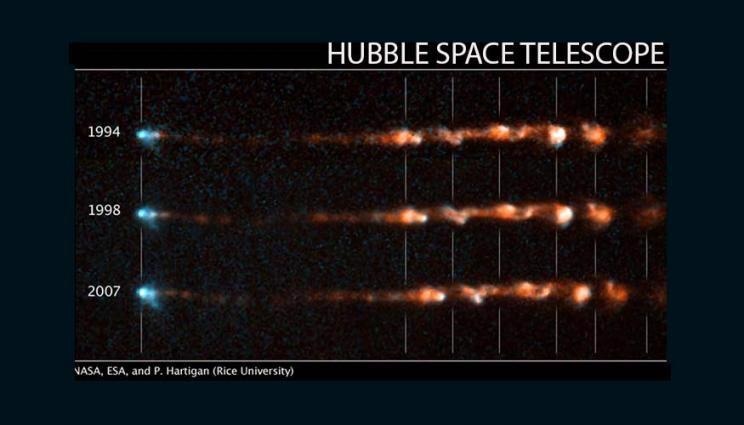Feb 25 2021
Matter outflows are common attributes arising from systems driven by compact objects like active galactic nuclei, black holes, accreting objects like Young Stellar Objects (YSO), pulsar wind nebulae and mature stars like the sun.
 This image taken with the Hubble Space Telescope shows how a bright, clumpy jet ejected from a young star has changed over time. Image Credit: NASA.
This image taken with the Hubble Space Telescope shows how a bright, clumpy jet ejected from a young star has changed over time. Image Credit: NASA.
However, the shape of such outflows, also called astrophysical jets, differ based on the magnetic field surrounding them.
Fresh experiments by a scientist from Lawrence Livermore National Laboratory (LLNL) and international collaborators reveal that outflow/magnetic field misalignment is a viable key process that regulates jet formation. The study was published in the Nature Communications journal.
The researchers used a high powered laser at the École Polytechnique to generate fast material outflows in a powerful applied magnetic field as a surrogate for prospective astrophysics conditions. They particularly analyzed how the jet formation is influenced by a misalignment between where the jet initially forms and then the magnetic field.
In the case of minor misalignments, a magnetic nozzle is formed, which redirects the outflow in a parallel jet. In the case of major misalignments, this nozzle turns more and more asymmetric, thus interrupting jet formation.
We found that outflow/magnetic field misalignment is a plausible key process regulating jet collimation in a variety of objects from our sun’s outflows to extragalatic jets. They also could provide a possible interpretation for the observed structuring of astrophysical jets.
Drew Higginson, Study Co-Author and Plasma Physicist, Lawrence Livermore National Laboratory
Astrophysical jets exhibit different morphologies ranging from collimated jets with extremely high aspect ratio to short ones that are either explicitly fragmented or are just observed and are unable to sustain a high density across a long range.
However, the mechanisms on which these different morphologies are based have been unclear.
The researchers took the observations made onto a range of astrophysical objects into account and proposed a probable scenario in which the relative orientation between the outflow and the large scale ambient magnetic field around the object could have a key role in orienting the outflow dynamics from a collimated one to a fragmented, stunted one.
The study collaborators are University of Chicago; Institute of Applied Physics RAS, Nizhny Novgorod, Russia; Sorbonne Université, École Polytechnique; Institut Polytechnique de Paris, Palaiseau, France; Université de Bordeaux-CNRS-CEA, Talence, France; Universitá di Palermo, Palermo, Italy; Heinrich Heine Universität Düsseldorf, Düsseldorf, Germany; Universiá di Torino, Torino, Italy; INAF-Osservatorio Astronomico di Palermo, Palermo, Italy; and Joint Institute for High Temperatures RAS, Moscow, Russia.
The LLNL part of the study was supported by the U.S. Department of Energy.
Journal Reference:
Revet, G., et al. (2020) Laboratory disruption of scaled astrophysical outflows by a misaligned magnetic field. Nature Communications. doi.org/10.1038/s41467-021-20917-x.